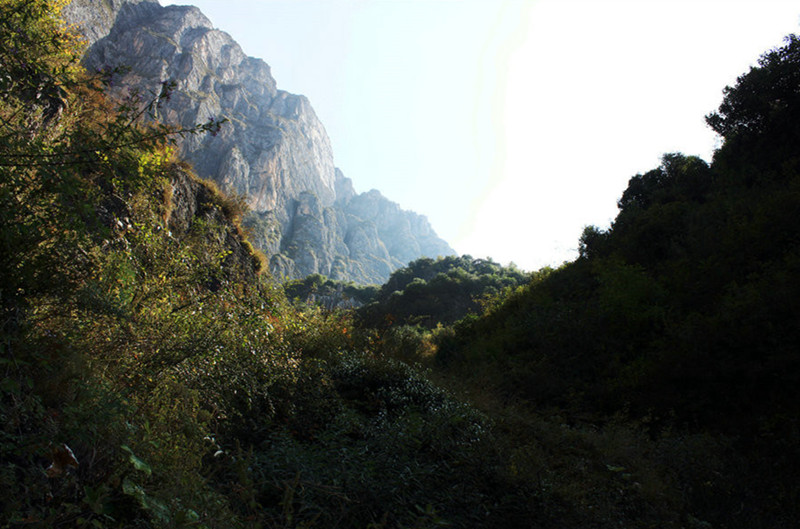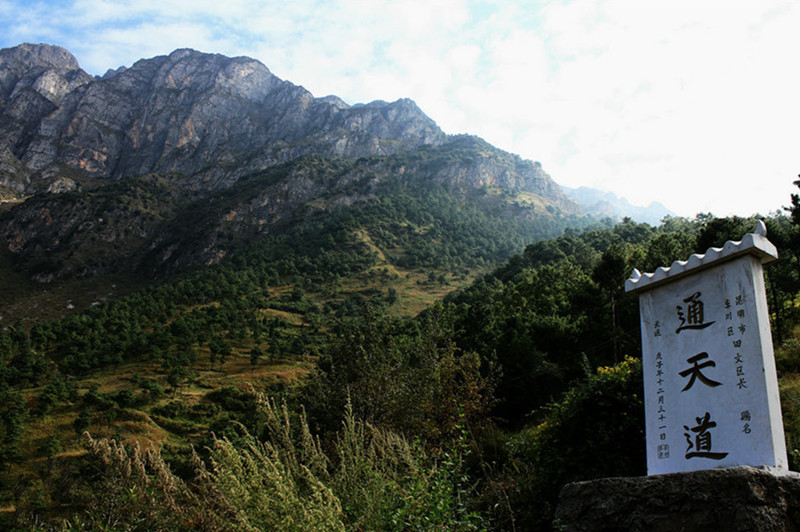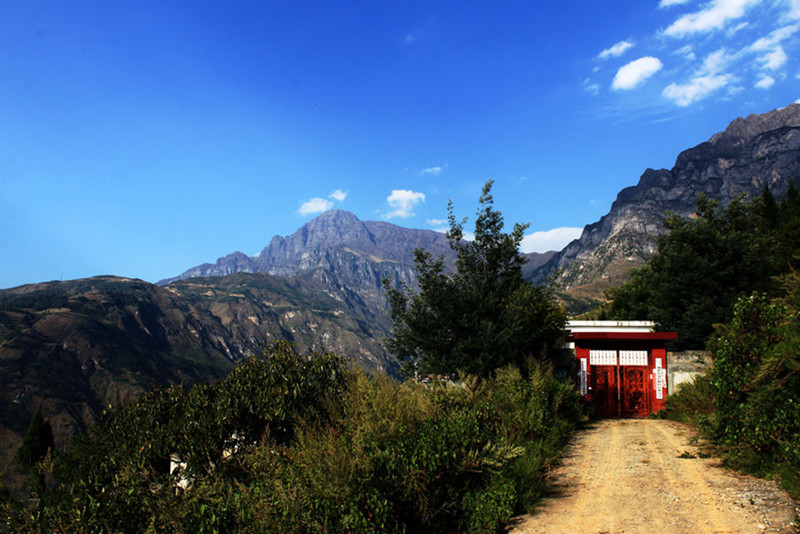
Guniushan Mountain in Dongchuan, Kunming
Introduction (简介)
Guniushan Mountain (牯牛山) features steep cliffs and towering peaks often shrouded in clouds. On clear days, its lush greenery is visible from hundreds of miles away. The Qing Dynasty poet Li Wenhan (李文瀚) wrote in his poem “Fortune in the Mountain” (《福在山》):
“去天刚尺五,蜗角有蛮屯。
终岁云埋顶,经时雪压门。
阴阳昏晓割,日月往来吞。
不识危亡地,犹矜遗子孙。”
This poem describes how, at a height of only “five feet” from the sky, there are minority villages inhabited by people who live under the clouds year-round, with heavy snow blocking their doors in winter. The majestic Guniushan stands as a natural barrier, clearly demarcating the weather changes, and it seems to consume the constantly moving sun and moon. For someone who has never been to the mountaintop, they might not realize that minority descendants still reside in such a high and perilous place.
Besides its breathtaking natural scenery, Guniushan is also captivating for its ancient traditions, enchanting legends, and rich folk customs.
The Highest Peak of the Wumeng Mountains (乌蒙山脉最高峰)
Dagu (大牯牛山), with an elevation of 4,017 meters, is the highest peak of the Wumeng Mountains (乌蒙山脉). The foothills lie in the Xiaojiang River Valley (小江河谷), with an altitude of just 695 meters, creating a remarkable relative elevation difference of over 3,300 meters, which is rare. Dagu stands vertically, reaching into the clouds, and very few have reached its summit throughout history.
Natural Resources (自然资源)
Majestic Canyon Landscapes (雄伟壮观的峡谷景观)
Guniushan is characterized by peaks resembling a forest, ridges interspersed like blades, deep canyons, steep cliffs, and an imposing atmosphere. The main peak consists of three interconnected spires of varying heights, creating an awe-inspiring sight that reaches for the sky.
- The First Spire (一尖峰) is the highest of Guniushan. The only way to reach its summit is from the back via the vast grassland. The weather at the peak is unpredictable, with clear skies suddenly turning stormy, bringing thunder, lightning, or hail! In moments, the sky might clear again. Watching the sunrise from the peak fills one with a sense of grandeur and inspiration. Looking south, one can see a vast sea of clouds; looking north reveals the expansive fertile fields stretching to the horizon, creating a breathtaking earthly paradise.
- The Second Spire (二尖峰) and The Third Spire (三尖峰) are surrounded by sheer cliffs, and no one has yet reached their summits. Vines extend thousands of feet down their sheer faces, and the peaks are adorned with lush grasses and vibrant flowers, bursting with spring life. The top of the third spire resembles the fishing platform of Jiang Ziya (姜子牙). In the misty sea below, Ziya, wearing a hat and cloak, fishes from his small boat, while two large carp leap out of the water—one of them snagging the hook. A person approaches from the shore, carrying a basket of fishing grass, followed by a small dog.
On the ridge in front of the third spire lies a massive stone boat, its ends curved like a crescent moon. Locals say it is magical; any animal that boards will be struck by lightning. In the past, many bones were found on the stone boat, sending shivers down the spines of those who saw them.
North of the third spire, a towering stone figure outlines a world filled with magical colors: Tang Seng (唐僧) calling upon Wukong (悟空); a giant dragon soaring, spreading spring rain; a thousand-year-old divine turtle surfacing; and the Eastern Sleeping Lion turning its head fiercely.
Vast Grasslands (万亩草山)
Behind Dagu is a vast expanse of grassland that stretches for thousands of acres. In spring and summer, the grass grows high, the willows fly, sheep scatter like clouds, and streams babble, winding beautifully. The mountains are adorned with colorful flowers. In autumn, the winds and clouds create a constantly changing atmosphere; the sky is clear and high, the grass turns yellow, and the landscape becomes soft like a blanket, refreshing the spirit. In winter, snowflakes drift, and mist envelops the area, resembling a northern wonderland.
A Typical Three-Dimensional Climate Area (典型的立体气候地区)
The complex mountain topography creates a three-dimensional climate in Guniushan, where “one mountain divides four seasons, and every ten miles has different skies.” This results in ever-changing weather patterns and various atmospheric wonders throughout the year.
In the afternoons during winter and spring, if fog rolls in on sunny, calm days, an “Amitabha Buddha Light” appears at the mountain’s peak, said to be encountered only by kind-hearted people. This light follows them as they walk and lingers, illuminating the rocks like gold, dazzling and dreamlike, as if stepping into a fairyland.
In autumn and winter, the clouds and mist swirl, making the peaks appear as if they are playing in the sea of clouds. At sunrise or sunset, the scenery is splendid, and one might feel the grandeur of “overlooking all mountains” and the ambition of “reaching for the stars.”
An Ancient Natural Animal and Plant Garden (古老的天然动物植物园)
Guniushan serves as a large, ancient natural garden, rich in biodiversity. The mountain is teeming with flowers and herbs, with vines draping even over rocks.
The numerous wildflowers are a prominent feature of Guniushan, with hundreds of species competing in color and beauty. Butterflies flutter amidst the flowers, filling the air with fragrance, creating a dreamlike scene! The wild lilies sway gracefully in the breeze, each stalk bearing five or six stunning red blossoms. The most famous is the vast rhododendron forest (万亩杜鹃) below Dagu, known for its diverse varieties and expansive area. When in bloom, the sight of endless rhododendrons stretches for ten miles, bursting with color, while larger rhododendrons create a lush backdrop of red, yellow, white, and blue flowers that complement each other beautifully.
On Guniushan, flowers are medicinal, and medicine can be floral. Angelica dahurica (白芷) is a precious traditional Chinese medicine that grows on cliffs, with large blossoms resembling umbrellas falling down the cliffs. The mountain’s rose flower is a rare gem among flowers, possessing high ornamental and medicinal value. Local herbalists claim that there are hundreds of medicinal herbs on Guniushan, including dozens of precious varieties like: Coptis chinensis (黄莲), rock flower (岩花), Artemisia annua (一枝蒿), toad lily (独角莲), snow tea (雪茶), and Fritillaria (贝母).
The rock sheep (岩羊) are the dominant animals on Guniushan. They often move alone or in small groups and seem to walk effortlessly along the steep rock faces.
The First Icefall of the Red Soil Plateau (红土高原第一冰瀑)
The icefall is a unique sight on Guniushan. Each winter, a giant icefall forms in the northern canyon, stretching over a thousand meters long and a hundred meters wide. This icefall sparkles brilliantly, radiating a chilling aura, and lasts for four to five months until the summer when it melts, earning the title of the first icefall of the Red Soil Plateau.
Cultural Resources (人文资源)
WWII Crash Site (二战期间美机坠毁地)
Numerous legends surround Guniushan, with the stories of the Immortal Cave (仙人洞) and the Crash Pavilion (坠机亭) being the most widely known and influential.
Immortal Cave (仙人洞) is a karst cave located on a 3,000-meter high cliff. The stalactite formations inside are breathtaking and crafted by nature. In the main hall, nine stone dragons converge, flowing with sweet and cool stone water, referred to by locals as “holy water.” To the left side of the hall is a kitchen, equipped with stone tables, bowls, and stools. The right side features a celestial platform containing stone Guanyin (石观音), stone Buddha statues, and stone incense burners. The hall also has a rhino pool where mysterious cow hoof prints and bones often appear; the hoof prints mysteriously reappear after being smoothed out. Locals say that an immortal once lived in the cave, gathering herbs to treat local illnesses. In the late 1960s, the immortal claimed to have achieved enlightenment and jumped off the cliff from the cave entrance. Today, only the immortal’s crumbling grave remains.
Crash Pavilion (坠机亭) is located on Xiaoguniushan (小牯牛山). According to locals, in early 1944, an American aircraft transporting munitions crashed into Guniushan due to dense fog obscuring the flight path. When locals arrived at the crash site the next morning, no one survived; only wreckage and artillery shells remained. Due to the difficulty of transporting them down, they were pushed over the cliff for protection. Research confirms that the crashed plane was a large transport aircraft from the China-US Hump route, established during the war at the cost of many lives. Guniushan bears witness to this historical event.
There is also a Stone Forest (石林) on the mountain, a large rock formation comprising a cluster of irregularly shaped stone pillars resembling trees.
Travel Tips (旅游攻略)
- Transportation: Travel by car is recommended. From Kunming, take the G56 Hunan-Guizhou Expressway to Dongchuan, and then switch to provincial roads leading to Guniushan. The trip takes about 4 hours.
- Entrance Fee: Currently, the entrance fee is 80 RMB per person, which includes a tourist bus to various scenic spots.
- Accommodations: There are several guesthouses and hotels near Guniushan. However, booking in advance is advised, especially during peak tourist seasons.
- Best Time to Visit: The best times to visit Guniushan are spring and autumn when the climate is pleasant, and the scenery is stunning.





 7 Days GolfingTour
7 Days GolfingTour
 8 Days Group Tour
8 Days Group Tour
 8 Days Yunnan Tour
8 Days Yunnan Tour
 7 Days Shangri La Hiking
7 Days Shangri La Hiking
 11 Days Yunnan Tour
11 Days Yunnan Tour
 6 Days Yuanyang Terraces
6 Days Yuanyang Terraces
 11 Days Yunnan Tour
11 Days Yunnan Tour
 8 Days South Yunnan
8 Days South Yunnan
 7 Days Tea Tour
7 Days Tea Tour
 8 Days Muslim Tour
8 Days Muslim Tour
 12 Days Self-Driving
12 Days Self-Driving
 4 Days Haba Climbing
4 Days Haba Climbing
 Tiger Leaping Gorge
Tiger Leaping Gorge
 Stone Forest
Stone Forest
 Yunnan-Tibet
Yunnan-Tibet
 Hani Rice Terraces
Hani Rice Terraces
 Kunming
Kunming
 Lijiang
Lijiang
 Shangri-la
Shangri-la
 Dali
Dali
 XishuangBanna
XishuangBanna
 Honghe
Honghe
 Kunming
Kunming
 Lijiang
Lijiang
 Shangri-la
Shangri-la
 Yuanyang Rice Terraces
Yuanyang Rice Terraces
 Nujiang
Nujiang
 XishuangBanna
XishuangBanna
 Spring City Golf
Spring City Golf
 Snow Mountain Golf
Snow Mountain Golf
 Stone Mountain Golf
Stone Mountain Golf




